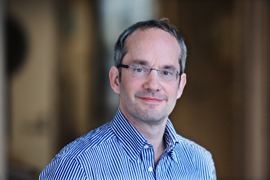Residence Germany Fields Cell biology | Name Anthony Hyman Nationality British | |
 | ||
Institutions European Molecular Biology LaboratoryUniversity of California, San FranciscoMax Planck Institute of Molecular Cell Biology and Genetics Thesis Establishment of division axes in the early embryonic divisions of Caenorhabditis Elegans (1987) Notable awards EMBO Member (2000)EMBO Gold Medal (2003)Leibniz Prize (2011)FRS (2007) | ||
Education Imperial College London | ||
Anthony Arie Hyman (born 27 May 1962) FRS is a British scientist and professor at the Max Planck Institute of Molecular Cell Biology and Genetics.
Contents
Education
Hyman was educated at University College London and King's College, Cambridge where he was awarded a PhD in 1987.
Research
Hyman has focused his career on examining microtubules and how these structures of the cytoskeleton control: cell division, mitotic spindle position, and cell polarity. Hyman's research has identified how microtubules are made into cellular structures and how they are broken down.
While at King's College, Cambridge, Hyman worked under the supervision of John White and was a key researcher in Sydney Brenner's C. elegans group. Using microscopy and microsurgery, he examined the placement of cell axes during early cell division of C.elegans embryos. Hyman presented new findings about mechanisms of rotation by cutting microtubules with a laser beam. Hyman demonstrated that pulling forces acting from the posterior cortex on microtubules drives spindle rotation.
At the University of California, San Francisco, Hyman investigated the interaction between chromosomes and microtubules that create the mitotic forces that separate chromosomes in the lab of Tim Mitchison. He also created a number of tools that are used today:
While at the European Molecular Biology Laboratory (EMBL) Hyman along with Rebecca Heald and Eric Karsenti combined their work to create an impact on the current understanding of how the meiotic spindle self assembles. Hyman created his first independent group at EMBL that discovered that the important factors in Xenopus egg extracts were the stabilizing protein, XMAP215 and the destabilizing protein, XKCM1.
In 1999, Hyman became one of the four founding directors of Max Planck Institute of Molecular Cell Biology and Genetics and was the Managing Director for the institute from 2010-2013. Hyman and his lab members are currently focusing on:
Hyman has worked on creating parts lists for cell division among human cells as part of the EU funded projects Mitocheck and MitoSys.
Awards and honours
In 2011, Hyman was awarded the Gottfried Wilhelm Leibniz Prize, Germany's most prestigious research award, for his work on microtubules and cell division. Hyman was elected a Member in 2000 of the European Molecular Biology Organization (EMBO) in 2000 and was awarded its Gold Medal in 2003. He was elected a Fellow of the Royal Society (FRS) in 2007.
